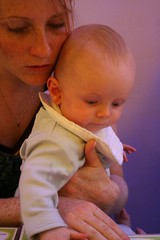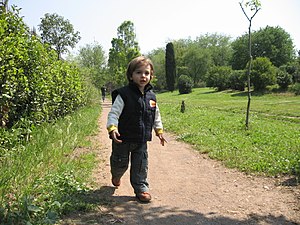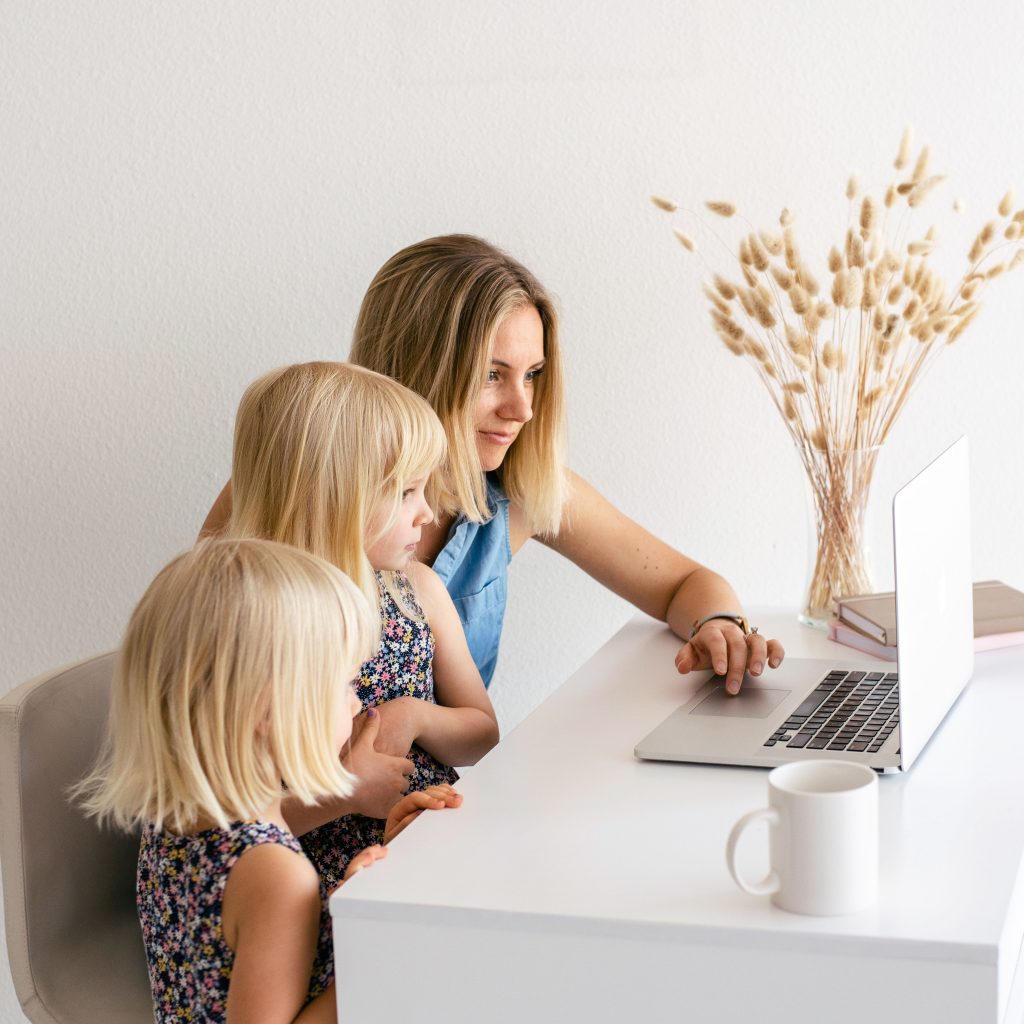Teaching Preschoolers In a Busy House
First published in Home School Enrichment Magazine, May/June 2010.
While two of my children studied quietly at the kitchen table, I gave my eldest son his weekly viola lesson. He was not far into the F Major Scale before a preschool-sized “Narnian Warrior,” complete with sword and shield, charged toward the violist, singing “Fo-o-or A-a-a-slan!” in tune to the scale.
After steering the Narnian out of the room and whispering a reminder not to interrupt music lessons, I turned toward the musician. “Did you notice your intonation problems at the top of the scale? Let’s repeat that, listening carefully.” A few moments of focused lesson time followed, with a few flashes of the warrior passing by. We turned to the exercises. As I concentrated on the violist’s hand position, I caught a glimpse of someone sneaking into the room, singing the exercise loudly so as to be undetected. The violist played on, seemingly oblivious.
“Didn’t I say to stay out?” I reminded him quietly, turning his body toward the family room.
“But, Mommy! I needed my Rocket Men!” My little guy looked imploringly across the living room at his new astronaut action figures, set up carefully on the piano bench.
“Then you should go around the other way, dear, so you don’t bother Mommy and your brother during the lesson, right?”
“Sorry, Mommy.” The two-year-old legs trotted happily around the hall and came through the other side of the room, and he quietly gathered his beloved toys.
The violist began working on his Bach piece soon. He had been making real progress, and soon both musician and mother were absorbed in bowing technique and phrasing. So we were both shocked several minutes later to hear sobbing.
“It won’t come off!” my preschooler cried, turning his little left arm nearly backwards in toddler fashion and pointing to the back of his shoulder in dismay. I could hear water running in the powder room next to us. The front of his shirt was drenched, as were his sleeves – except the back of his shoulder. That, along with the top of his head, parts of his face, and his feet, was covered in a mysterious white powder.
My brow furrowed in puzzlement. I followed the trail of white to the kitchen, the criminal following me. “I’m still cleaning up!” he insisted. “Don’t go in there!” That made me hurry faster, whereupon I found a half-emptied box of cornstarch overturned on the floor. Beside it sat my dustpan, half filled with the corn starch. I was impressed; in a few more minutes he would have cleaned it all by himself.
Homeschool Moms are busy women, whether we teach one child or a dozen. Too many worry about how to provide adequate stimulation and academic growth for their youngest children. Much of this is due to the media pressure and early childhood education propaganda. “No Four-Year-Old Left Behind,” “Reading Readiness,” and “Baby Einstein” program marketing can leave us feeling as if we are inadequate for the training of these small dynamos. Mothers are left wondering,“How can I teach my toddler or preschooler in an already busy household?”
The answer to this question can be found in three simple reminders.
1. Recognize the learning taking place already within the home. For instance, notice what was happening during that thirty-minute viola lesson. My little guy benefitted from an entire preschool curriculum including large motor development (trotting freely around the downstairs), imaginative play (enacting scenes from his favorite read-aloud), science (Rocket Men), music (singing scales and Bach), two-hand co-ordination (sweeping with a broom and pan), inter-personal skills (not interrupting), and hygiene (washing hands).
Everyday activities form the basis of learning for preschool children. Running errands, talking with parents and siblings, cleaning the house, and eating dinner are learning events. Even bath and snuggle time are opportunities for a child to learn about himself, his environment, and his loved ones.
An alert parent can make the most of such events to build on existing learning. A child with a good vocabulary can begin pronouncing difficult sounds more clearly, with patient help. A music lover can learn to identify instruments by sound, increasing aural discrimination. A child good with colors can begin sorting and counting. Building on skills little by little within a loving home encourages a true love for learning.
2. Include your preschooler in his older sibling’s classes. A preschooler will benefit greatly from sitting in Bible Time with the rest
of the children. While holding his picture Bible, he will grow to love Moses, Daniel, and Paul and to respect God’s Word. He will learn with the others to sit still, to sing praises to the Lord, and to respect the things of God first of all.
Little children are enthralled with their sibling’s science projects. They have a natural love for God’s creation and respect for their brothers’ work. They enjoy watching Big Brother perform a science experiment, or listen to Big Sister explain a model and answer questions. My preschooler thinks these events are the best messes we ever make in our studies!
Read Aloud Time and Recitation are both good opportunities to develop the preschooler’s love for literature. As older siblings recite memorized poems and speeches, your preschooler will grow to enjoy the cadence and beauty of well-chosen words. Soon the little one will want to memorize verses and short pieces, too.
3. Train your preschooler to work and play alone. This is an important skill if Mom is going to teach or work in her home efficiently. From babyhood onward, your child can be taught to have increasing amounts of time
to himself to safely explore his play space and toys. By the time he is a preschooler, he may stay in his room part of the time you are teaching older students or doing housework. This gives him the freedom to imagine and play on his own, as well as a chance to learn to clean a specific area properly when he is done. My preschooler often likes to “do studies” next to me while his older siblings work on their papers. I will hand him a coloring paper and his crayons with instructions to do the paper “quietly, in orange” or another specific color. He will furrow his little brow, looking carefully for the correct color, tip-toeing over to me to ask if he is holding the correct crayon before he is ready to begin. Coloring quietly on his papers teaches him to concentrate quietly on his work without disturbing others.
During such a quiet work time, your preschooler can “read” his board books, play with math manipulatives, put together puzzles, or even explore the kitchen pots and pans. The key is for him to quietly concentrate and creatively solve his own problems. And don’t forget the all-important last lesson: put it all away! God has given us “all things that pertain unto life and godliness, through the knowledge of Him that hath called us to glory and virtue.” So let us not fear training our young ones for His honor. The Lord will give us wisdom for the task (James 1:5).
_____________________________________________________________________________________
Activities for Preschoolers
To Learn Alone while Mom is Teaching Others
- Fill a dishpan with water, and place on floor. Allow child to play in it with measuring cups and spoons, then clean up his own mess with a towel and put the towel in the washing machine. Responsibility, Math (Volume), Imagination
- Before donating out-grown or past fashion clothes to the thrift store, let your child play “dress up.” Imagination, Large and Fine Motor Skills
- Fill a bucket with water, hand the child a paint brush, and let him “paint the house” on the siding. Imagination, Large Motor Skills
- Save junk mail catalogs and workbook pages. Child cuts out pictures and glues them to construction paper for a collage. Art, Fine Motor Skills
- Child can explore backyard alone outside the kitchen window. Give him a plastic spoon to dig or a pad of paper to sketch. Science, Imagination, Art, Fine Motor Skills
- Sort pattern blocks, teddy bears, coins, linking cubes, or beads into cups, jars, or other containers. If possible, explain sorting rule. Older preschoolers sort again by a different rule (size, color, or shape). Math Skills, Small Motor Skills, Vocabulary
Lea Ann Garfias is a homeschool graduate who has found teaching private violin and piano lessons much more exciting with a preschooler armed with a (play) sword nearby. She and her husband, David, are enjoying teaching their four children in the Dallas area. You can read more of her articles on Early Learning in Home School Enrichment Magazine. Request your free sample copy of the magazine or subscribe today!
Copyright 2010 Lea Ann Garfias and Home School Enrichment. Unauthorized use, duplication and/or distribution of these articles without express and written permission from the author and/or magazine is strictly prohibited. Excerpts and links may be used, provided that full and clear credit is given to Lea Ann Garfias and HSE with appropriate and specific direction to the original content.




Leave a Reply